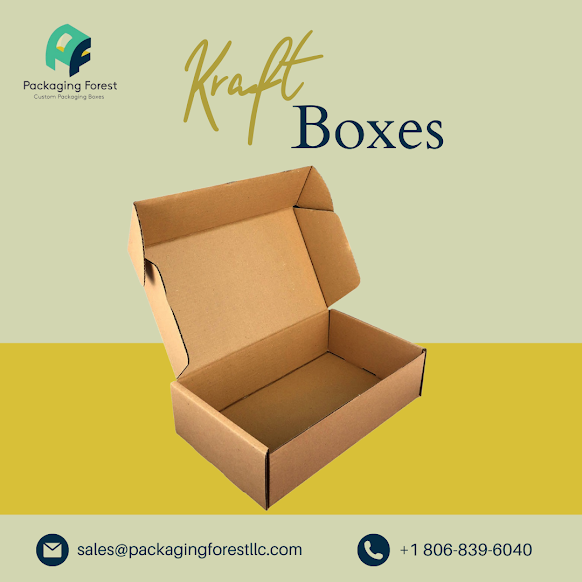Embracing Style The Versatility of Kraft Boxes
Sustainable and ecologic packaging options have received more attention in recent years. The adaptable and environmentally conscious option of kraft Boxes is one of the top alternatives for environmentally conscious enterprises.
Understanding Kraft Boxes
1. Recycled Materials: The materials used for creating them are often recycled, predominantly paper or cardboard. These elements not only reduce wastage but also help develop packaging that is healthier for the environment.
2. Robust and Durable: They are comparable in terms of durability to conventional containers while maintaining the strength of their structure. They provide secure storing and moving of a range of items and provide great protection.
3. Natural Aesthetics: The boxes' organic brown color gives the package a hint of genuine and rustic appeal. Customers that prefer an additional organic or natural existence gravitate towards this straightforward but attractive aesthetic.
Versatility in Packaging
1. Retail Applications: These applications are quite adaptable and useful for a range of retail sectors. They are often utilized by package goods including food, candles, handcrafted goods, cosmetics, and beyond. Because these boxes are neutral in colors, the things throughout may be shown in a simple and natural way.
2. Branding That Can Be Customized: While Custom Kraft Boxes possess a distinctive look, there are also a lot of opportunities for personalization. Businesses can simply add their labels, logos, or custom messaging to their packaging, improving brand awareness and maintaining a consistent packaging experience.
3. Gift packing. They are ideal for special events like anniversaries, marriage ceremonies, or holidays because of their natural aesthetics, which lend the box a warm and unique touch. In order to provide a distinctive and unforgettable presentation, they may also be embellished with strings of ribbons, strings of twine, or other floral components.
Environmental Sustainability
1. Fully recyclable and biodegradable: The capability to be recycled and biodegraded makes them an effective choice among shoppers who care about the environment. These boxes may be reused for recyclable goods after completing their intended use or permitted to break down naturally while harming the surroundings.
2. Lessened Carbon Footprint: By using recycled materials, these boxes help to lower the quantities of energy and greenhouse gas emissions produced during the production of brand-new packaging materials. Selecting these boxes displays a commitment to fiscal responsibility and is in line with sustainable practices.
3. Consumer Appeal: As sustainable products and packaging become more popular, customers provide a practical answer that aligns with their principles. Businesses may draw in and sustain environmentally conscientious consumers while improving brand impression through using environmentally conscious packaging.
Practicality and Cost-Effectiveness
A. Simple Assembly: It usually takes a little effort and time to put them together. This enables effective packing procedures, conserving organizations' precious time.
B. Cost-Effective Other: They are often a more cheap option for companies of all sizes if compared with alternative packaging materials. In addition to promoting ecological objectives, the application of recycled supplies lowers costs.
“Printing Process for Kraft Boxes”
Kraft Boxes Wholesale refers to the bulk purchase of kraft boxes from manufacturers or suppliers at a discounted price.
Printing Process for Kraft Boxes
1. The use of offset printing is a popular method for printing designs of superior quality on packaging. This includes moving the chosen artwork on an aluminum plate to rubber pillows, subsequently onto the container's surface. Offset printing provides accurate color replication and is appropriate for complex or elaborate designs.
2. Flexographic Printing: Flexographic printing represents an additional well-liked box printing method. For the transfer of ink to the box surface, a movable relief plate with the required design has to be created. Flexographic printing is a good choice for high-volume reproduction since it produces rich, even color.
3. Digital Printing: The digital printing process is a cutting-edge and adaptable printing technology that becomes more and more popular for boxes. Leveraging inkjet or laser technologies entails printing digital pictures on the box surface. Digital printing is ideal for short print runs or bespoke work since it has rapid turnaround times and variable information printing capabilities.
4. Screen printing: It involves applying dye to the box surface by pushing it through a mesh screen. It is a flexible printing process that is capable of producing unusual effects and hues that are strong and thick. The technique of screen printing is frequently utilized for designs that call for a thicker ink coating or to give the image printed texture.
5. Hot Stamping: The hot stamping process is a technique for adding colored pigments or metallic foil onto the surface of metal boxes. The sheet of foil or pigments forms a unique film and must be transferred inside the box under pressure and heat. When adding logos, lettering, or ornamental components, hot stamping typically results in striking glossy or glossy surfaces.
Businesses may use these printing methods to add their corporate identity, logos, paintings, or advertisements to these boxes, boosting the aesthetic appeal and reputation associated with the packaging.

Comments
Post a Comment